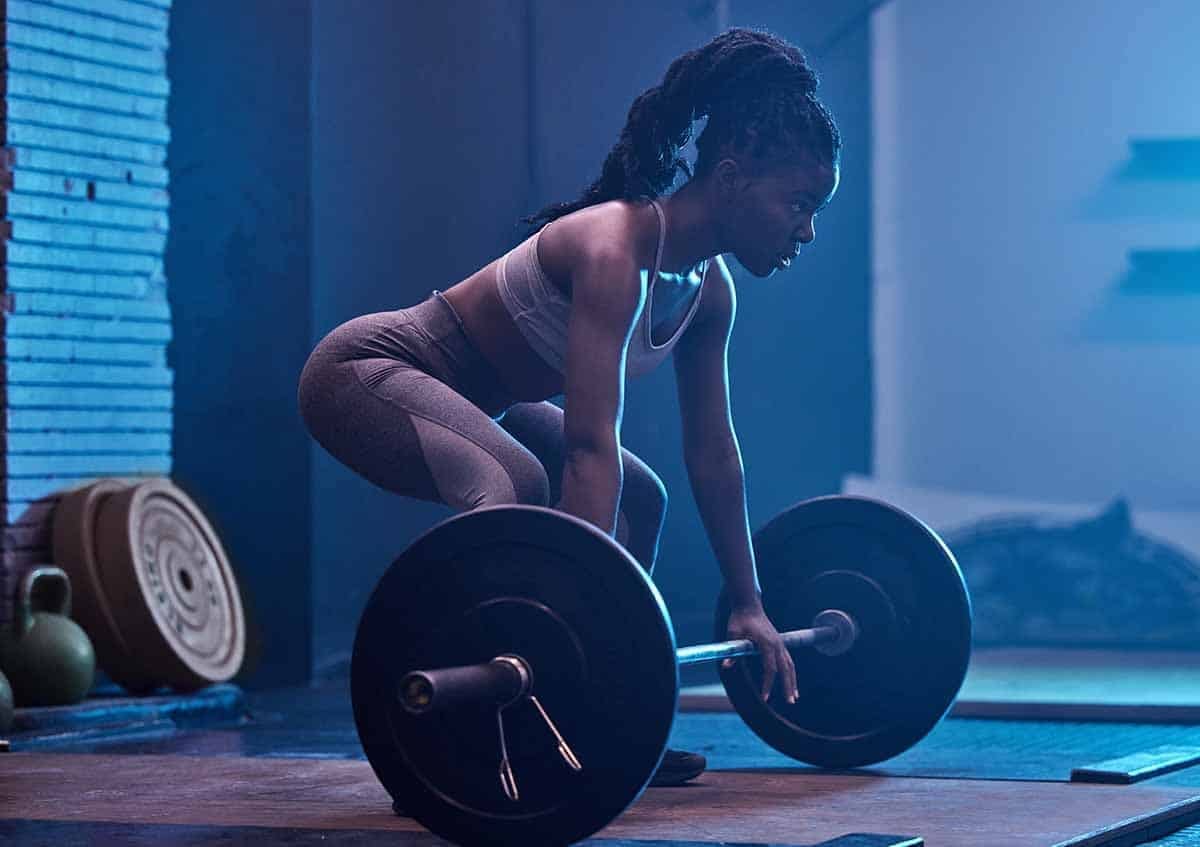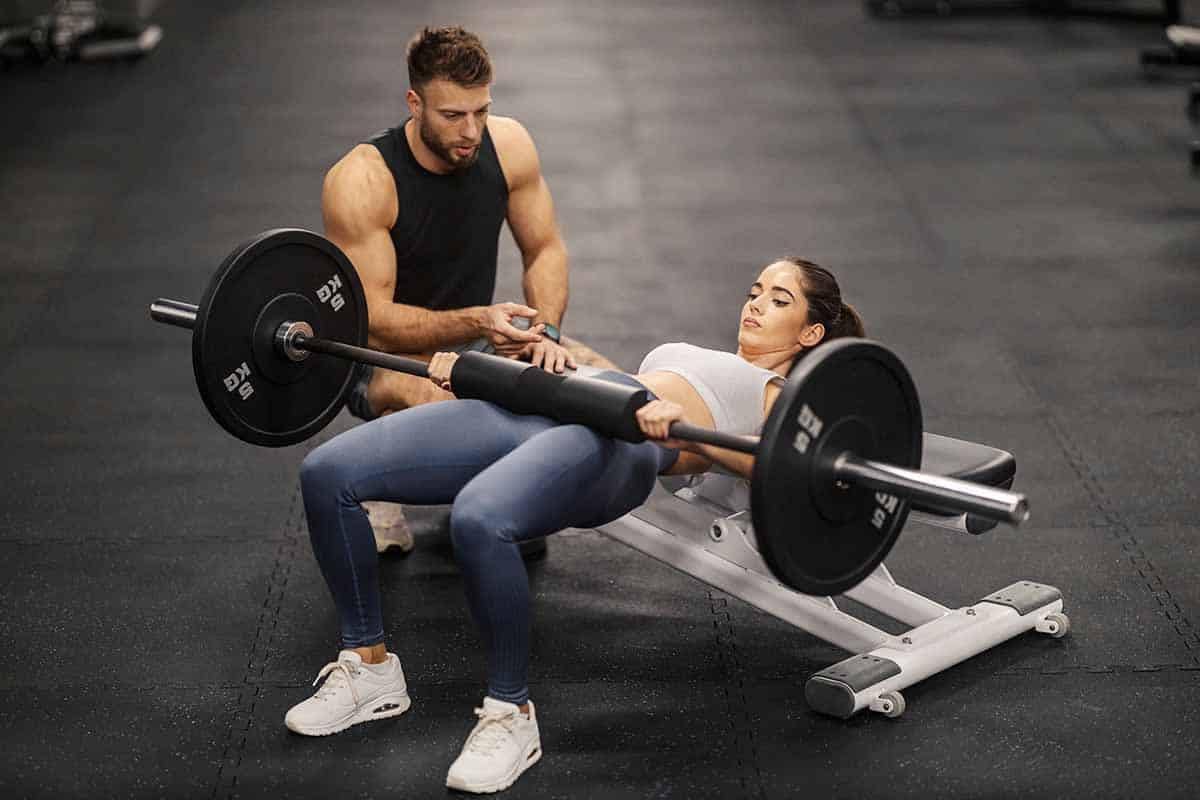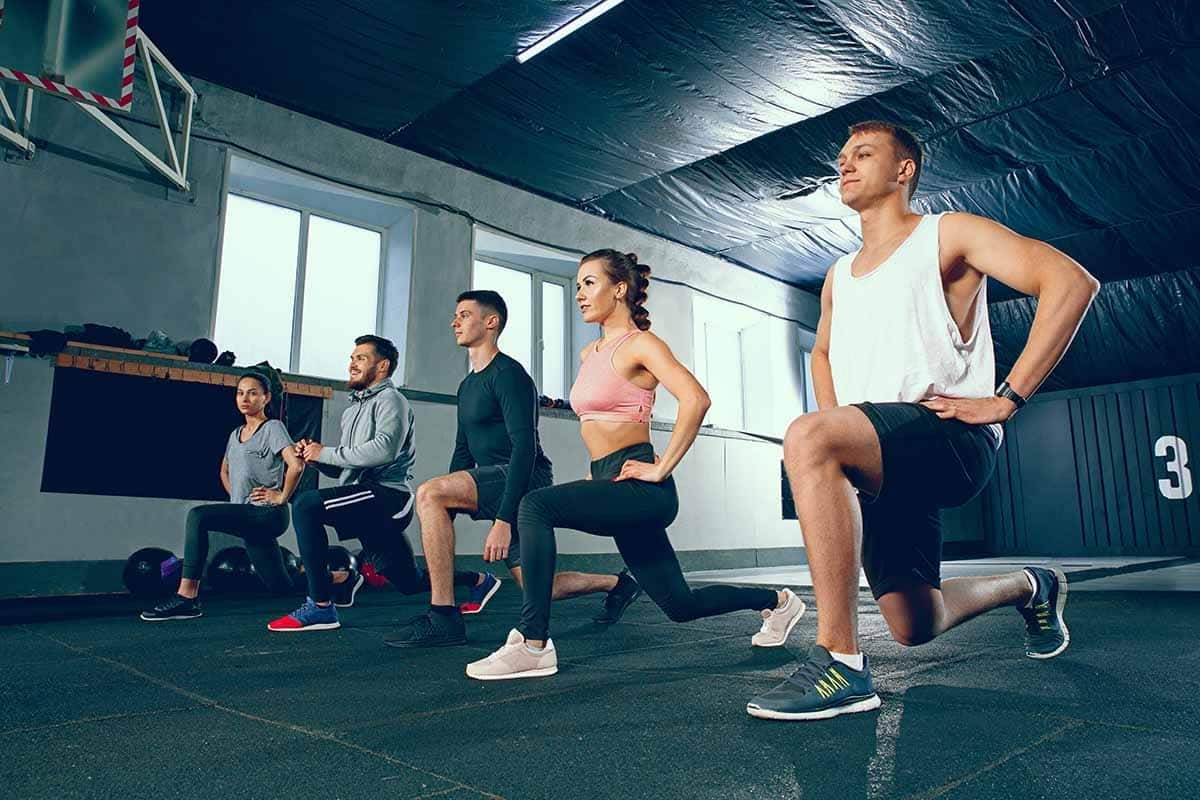Top 5 Compound Glute Exercises: Boost Strength & Get Toned
Deadlift, bulgarian squat, and more compound glute exercises you can do to get tones and boost your strength. Check out these workout plans
If you want to build a rounder rump, focus on working your glutes first during your workout routine. In this case, compound glute exercises are the perfect option.
Exercising the glutes (aka, your butt muscles) is not only a fantastic way to work towards a round butt, heart-shaped ass or the coveted shelf butt, but it’s also functional too!
Did you know that stronger glutes may help you walk more efficiently, excel in sports, and even reduce back pain?
This article will walk you through how to use compound glute exercises to strengthen your butt. Find out our top 5 picks and why they’re so beneficial. We’ll also provide simple how-to guides and visuals so you can master your form with confidence.
What Are Compound Glute Exercises?
A quick word on compound workouts:
“Compound” (as opposed to its opposite: isolation workouts) means multi-joint movements that engage multiple muscle groups at the same time to give you a more comprehensive workout.
So, it follows that compound glute exercises are any type of multi-joint or multi-muscle move that you’d use to target your glutes.
On top of your butt muscles, these exercises often involve your legs, hips, and core muscles. This makes compound workouts one of the most effective ways to target your whole lower body for strength and stability.
A few examples of these moves (which we’ll discuss in more detail shortly) include: squats, deadlifts, lunges, hip thrusts, and Bulgarian split squats.
When you work across several muscles and joints at once, you can build up your functional strength, balance, and athletic performance, while encouraging a stronger, more toned backside.
Best Compound Glute Exercises
So now that we understand compound vs. isolation exercises as they apply to your glutes, here are five of the best compound glute exercises with simple explanations for you to follow:
1. Barbell Back Squat
- Set-Up: Place a barbell on a squat rack at shoulder height. Step under the bar, place it across your upper back and hold it securely. Lift the bar off the rack and step back at least a foot away from the rack.
- Body Position: Stand with your feet shoulder-width apart. Keep your toes slightly pointed out. Hold your chest up proudly. Make sure your core muscles are engaged, and your back is straight.
- Action: Bend your knees to lower your body. Keep going, until your thighs are parallel to the ground at a 90-degree angle or slightly lower for a deeper variation.
- Reverse: Drive out of your heels to return to the standing position.
- Reps: 8-12 reps per set.
Hate squatting with a barbell? The hack squat may be your best friend. Read up on our guides to hack squat vs squat and variations like the Smith machine hack squat or landmine hack squat you can do using a hack machine or other simple equipment.
2. Deadlift
To deadlift:
- Set-Up: Stand with your feet hip-width apart, keeping a loaded barbell or two dumbbells around your mid-foot area. Bend down, hinging from your hips to grip the bar with your hands slightly outside of your knees.
- Body Position: Keep your back straight, chest proud, and shoulders back. Make sure you’re hinging at the hips and keeping a bend in your knees.
- Action: Lift the bar by straightening your hips and knees at the same time until you're standing upright.
- Reverse: Lower your bar back to the ground with control by bending back through your hips and knees.
- Reps: 3-6 sets 8-12 reps if you are using light weight. If you’re experienced with heavy weights, you may want to try for a one-rep max or 5-rep max to tap into your full strength potential.
Pro-Tip: If you want more even hamstring and glute activation than a conventional deadlift, use a narrower stance. Stepping your feet closer than hip-width apart will better activate these muscles.

There are many other deadlift variations you can experiment with as well. Here are just a few options you can read up on in our guides to deadlifts and variations.
3. Hip Thrust
This exercise is often overlooked, but Hip Thrust is actually incredibly effective for building a strong and shapely booty. This is because compared to a squat or deadlift, it puts more direct emphasis on your glutes, yet it’s still a compound move.

You can often lift more weight here than you think, so don’t be shy to go heavy in your hip thrusts.
- Set-Up: Sit on the ground with your upper back against a bench and a barbell over your hips. Roll the barbell over your hips.
- Body Position: Place your feet flat on the ground, shoulder-width apart with your knees bent. Remember to keep your back straight and your abdominals engaged. Your upper back should be resting on the bench.
- Action: Push into your heels to lift your hips up toward the ceiling. Squeeze your glutes at the top.
- Reverse: Hold for a moment, then slowly lower your hips back to the ground with control.
- Reps: 3 sets of 10-15 reps per set.
Pro-Tip: The barbell has a tendency to dig into your hips or bash against your hip bones, especially for slimmer people. If you notice this is an issue, roll up a yoga mat, gym mat, or towel and place it between your hips and the bar. Some commercial gyms also offer designated pads that you can wrap around your barbell for comfort.
You may find the hip thrust and glute bridge similar to each other. To distinguish these exercises and find out which is the perfect workout for you, check out glute bridge vs hip thurst.
4. Lunges

- Set-Up: Stand with your feet hip-width apart and your hands on your waist.
- Body Position: Keep your chest up and core engaged.
- Action: Step forward with one leg, lowering your hips until both knees are bent at about 90 degrees. Your front knee should be directly above your ankle. Try to keep your torso upright the whole time.
- Reverse: Drive out of your front heel to come back to your starting position.
- Reps: 3-4 sets of 10-12 reps each leg. You can alternate sides or perform a half set with one leg, then complete the set with your second leg.
Pro-Tip: Add dumbbells in your hands or a barbell over your shoulders for an extra challenge.
5. Bulgarian Split Squat
- Set-Up: Stand about two feet in front of a bench, facing away from it. Pop one foot on the bench behind you with the top of your foot propped against it.
- Body Position: Keep your chest up, back straight, and core engaged the whole time.
- Action: Bending your front knee to drop your body down until your thighs come parallel to the ground. Your back knee should hover just above the ground.
- Reverse: Drive out of your front heel to come back up to your starting position.
- Reps: 3-4 sets of 10-12 reps each leg.
These exercises will help you hammer the glutes while also working through multiple joints and supporting leg muscles for a full low-body workout.
If you follow along with these simple tips and focus on proper technique, you can get stronger, more coordinated and do an aesthetic workout for your legs.
Compound Glute Exercises— Tips and Tricks
And now for a few housekeeping rules.
Compound glute exercises can only have their desired effect if you do them right. Here are some tips and tricks for expert form and healthier leg workouts.
Proper Foot Placement
Make sure your feet are positioned correctly for each exercise. For instance, in squats, your feet should be shoulder-width apart with your toes slightly turned out as a standard stance. Understanding the “standard” or “basic” version of an exercise can help you work into variations that will better hit the muscles you want them to.
For instance, if you widen your feet in a squat (this is usually called a “sumo squat”), you place more emphasis on the adductors (your inner thigh muscles). You’ll only know this, though, if you understand the baseline that you’re working off of.
Warm-Up
Always start with a good warm-up. Think dynamic stretches and light cardio to get your blood pumping. Anything that gets you moving to the point where your heart rate elevates and you maybe break a light sweat can be used to warm you up.
With warm muscles, you’ll be able to use your range of motion more effectively and avoid injuries when it comes to your heavy lifts.
Stay Consistent
The best results come from sticking to your routine. Keep at it, and you’ll see progress over time. Watching yourself in a mirror or recording your exercises with a tracker app like Flex Fitness can help you identify and correct form issues while staying on track to hit your goals.
Guide to Glute Muscles
Here’s a little guide to help you understand gluteus muscle anatomy.
1. Gluteus Maximus
- What is the gluteus maximus? This is the big, round muscle that gives your butt its shape.
- What does your gluteus maximus do? It helps you internally and externally rotate your thighs and flex the muscles of your hips. Your gluteus maximus lets you stand up, climb stairs, and move your leg backward. It's the powerhouse of your glutes and can generate a lot of force, both when you work out and perform regular daily activities.
- Where is your gluteus maximus? Your gluteus maximus covers most of your buttocks (the cheeks!). It runs from your lower back and pelvis down to the top of your thigh bone.
2. Gluteus Medius
- What is the gluteus medius? This medium-sized muscle hides under your gluteus maximus.
- What It Does: Your gluteus medius helps keep your hips stable and moves your leg out to the side (hip abduction). It also helps you keep your balance when you walk or run.
- Where It Is: On the outer surface of your pelvis, this muscle attaches to the top of your thigh bone (femur).
3. Gluteus Minimus
- What is the gluteus minimus? Your smallest and deepest glute muscle.
- What does your gluteus minimus do? This muscle helps your gluteus medius out. Both muscles work to move your leg out to the side and keep your pelvis stable. It also helps rotate your thighs inward. You can even target this muscle independently with gluteus minimus exercises!
- Where is the gluteus minimus: This small but powerful muscle sits underneath your gluteus medius, from the outer pelvis to the top of your thigh bone.
Weekly Workout Plan With Compound Glute Exercises
If you’re beginning to structure your workout routine week by week, and you want to make growing your glutes a priority, you’re probably wondering what type of workout plan or split will let you train these big muscles often enough to see significant results.
Here’s a plan you can use to begin building your weekly workout routine that emphasizes compound glute workouts.
Lower Body Strength: Day 1
- Barbell Squats: 3 sets of 8-12 reps
- Deadlifts: 3 sets of 8-12 reps
- Lunges: 3 sets of 10-12 reps per leg
Upper Body: Day 2
- Focus on exercises like push-ups, pull-ups, and dumbbell presses. Give your glutes a break today.
Active Recovery: Day 3
- Light activities like walking, yoga, or stretching. Keep things low-key and let your muscles recover.
Lower Body Strength: Day 4
- Hip Thrusts: 3 sets of 10-15 reps
- Bulgarian Split Squats: 3 sets of 10-12 reps per leg
- Plank with Leg Lift: 3 sets of 15 reps per leg
Cardio & Core: Day 5
- 30 minutes of cardio (running, cycling, or swimming)
- Core exercises like Russian twists, bicycle crunches, and planks
Lower Body: Day 6
- Barbell Squats: 3 sets of 8-12 reps
- Deadlifts: 3 sets of 8-12 reps
- Hip Thrusts: 3 sets of 10-15 reps
Rest and Recover: Day 7
- Take it easy! Your muscles grow when you rest, so enjoy a relaxing day.
As you can see, you have three opportunities to train compound glute exercises during this type of plan. Compared to a split like push-pull-legs, where you only get two glute and leg training days or the bro split workout, with only one, you’re putting a lot more volume on your glutes in this type of plan.
If you’re struggling to build your glutes, a plan like this can be a great kickstarter as you work toward a stronger, more powerful lower body.
Benefits of Compound Glute Exercises
Let's check out the benefits that compound glute exercises have:
Functional Movement
Your glutes help you walk, run, jump, and climb. They're all about making big moves and keeping you mobile.
Stability
These muscles keep your hips and lower back stable, which means better balance and posture. This is especially true if you play sports or do other physical activities requiring balance or standing for long periods.
Strength
Strong glutes mean a stronger lower body, less risk of injury, and better performance in pretty much any physical activity.
So, keep your glutes strong and happy with exercises that target these muscles. You'll move better, feel better, and maybe even look better.
Big Picture
A great booty doesn’t just look good.
Working the muscles of the glutes has many benefits like:
- Better lower body strength
- Improved balance
- More overall stability.
When you train your glutes with multiple muscle groups simultaneously, your workouts can feel more efficient and effective. They help build a stronger, more toned derriere while also supporting better posture and reducing the risk of injuries.
Compound glute exercises can also help your athletic performance and functional fitness, making everyday movements easier and more powerful.
References
Elzanie A, Borger J. Anatomy, Bony Pelvis and Lower Limb, Gluteus Maximus Muscle. [Updated 2023 Apr 1]. In: StatPearls [Internet]. Treasure Island (FL): StatPearls Publishing; 2024 Jan-. Available from: https://www.ncbi.nlm.nih.gov/books/NBK538193/
Gentil, P., Soares, S., & Bottaro, M. (2015). Single vs. Multi-Joint Resistance Exercises: Effects on Muscle Strength and Hypertrophy. Asian journal of sports medicine, 6(2), e24057. https://doi.org/10.5812/asjsm.24057
Greco AJ, Vilella RC. Anatomy, Bony Pelvis and Lower Limb, Gluteus Minimus Muscle. [Updated 2023 May 22]. In: StatPearls [Internet]. Treasure Island (FL): StatPearls Publishing; 2024 Jan-. Available from: https://www.ncbi.nlm.nih.gov/books/NBK556144/
Plotkin, D., Coleman, M., Van Every, D., Maldonado, J., Oberlin, D., Israetel, M., Feather, J., Alto, A., Vigotsky, A. D., & Schoenfeld, B. J. (2022). Progressive overload without progressing load? The effects of load or repetition progression on muscular adaptations. PeerJ, 10, e14142. https://doi.org/10.7717/peerj.14142
Shah A, Bordoni B. Anatomy, Bony Pelvis and Lower Limb, Gluteus Medius Muscle. [Updated 2023 Feb 17]. In: StatPearls [Internet]. Treasure Island (FL): StatPearls Publishing; 2024 Jan-. Available from: https://www.ncbi.nlm.nih.gov/books/NBK557509/
Related articles


Get fit with Flex
Build muscle & lose weight fast for free.
Available on iPhone + Apple Watch





